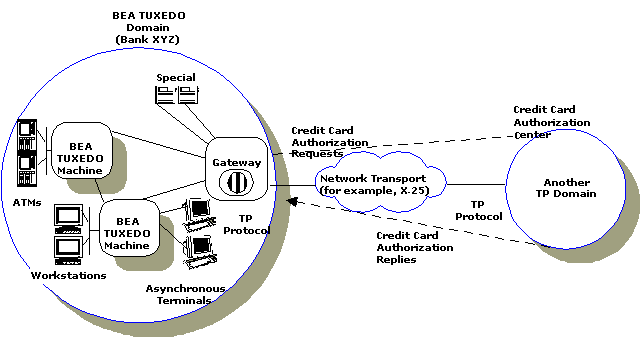


|

|
|
|
|
Example of an Application Using Domain Gateways
The following figure shows a BEA Tuxedo application that requires services (in this case, credit card authorizations) from a remote domain.
High-level View of Two Communicating Domains
The application also accepts service requests (for example, balance inquiries) from remote domains. The gateway process provides bidirectional transaction control, and administrative tools for configuring a local domain to interoperate with other domains. BDMCONFIG, the configuration file for a multiple-domain application, identifies exported services, imported services, addressing, and any access control lists to be used. The following figure shows a more detailed view of a sample Domains environment. Example Domains Environment
The example shows a credit card authorization center running under the control of the BEA Tuxedo system. The authorization center has two gateway groups: bankgw1 (which uses the TCP/IP protocol) and bankgw2 (which uses the OSI TP protocol). bankgw1 provides access to two remote BEA Tuxedo domains (Bank ABC and Bank CBA); bankgw2 provides access to one remote domain (Bank XYZ) using the OSI TP protocol. In this example, Bank ABC generates service requests to the credit card authorization center. These requests are received by a gateway running within group bankgw1. This gateway issues a service request, on behalf of the remote domain, to the credit card authorization service provided by a local server. The server processes the request and sends the reply to the gateway, and the gateway forwards the reply to Bank ABC. The credit card authorization center may also issue service requests. For example, the authorization center may send balance inquiries to Bank XYZ. Domains makes this possible by providing a gateway that acts like a local server that advertises services available in other domains as if they were local services. Domains provides the notion of a local domain that controls incoming requests and provides a generic addressing framework for the application. Local domains help to provide partial views of an application, that is, a subset of the local services available to a set of remote domains. Each local domain is always represented by a single gateway server group.

|

|
|
|
|
Copyright © 2001 BEA Systems, Inc. All rights reserved.
|